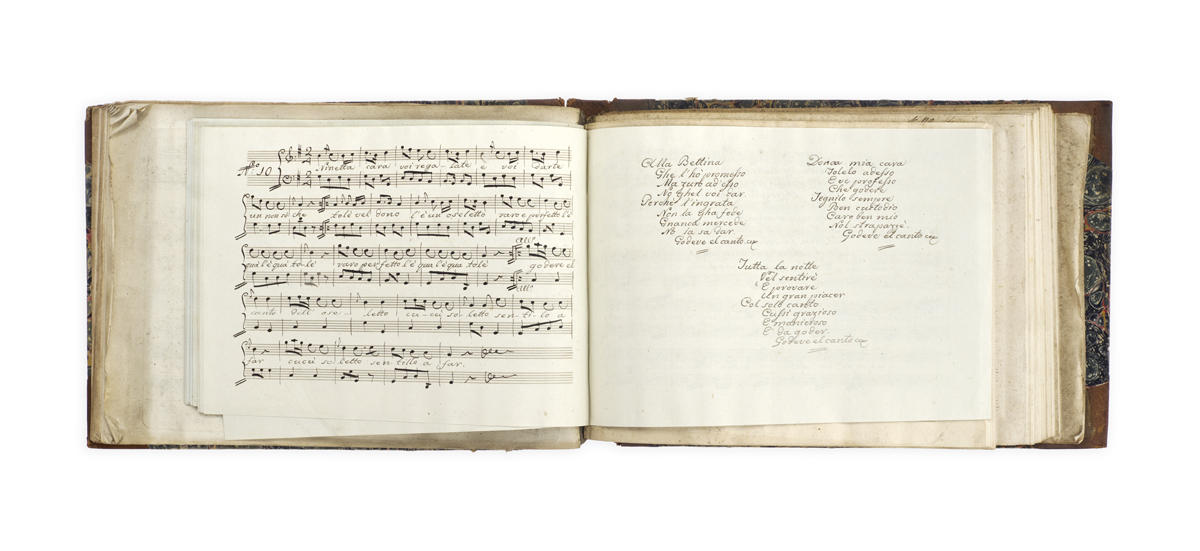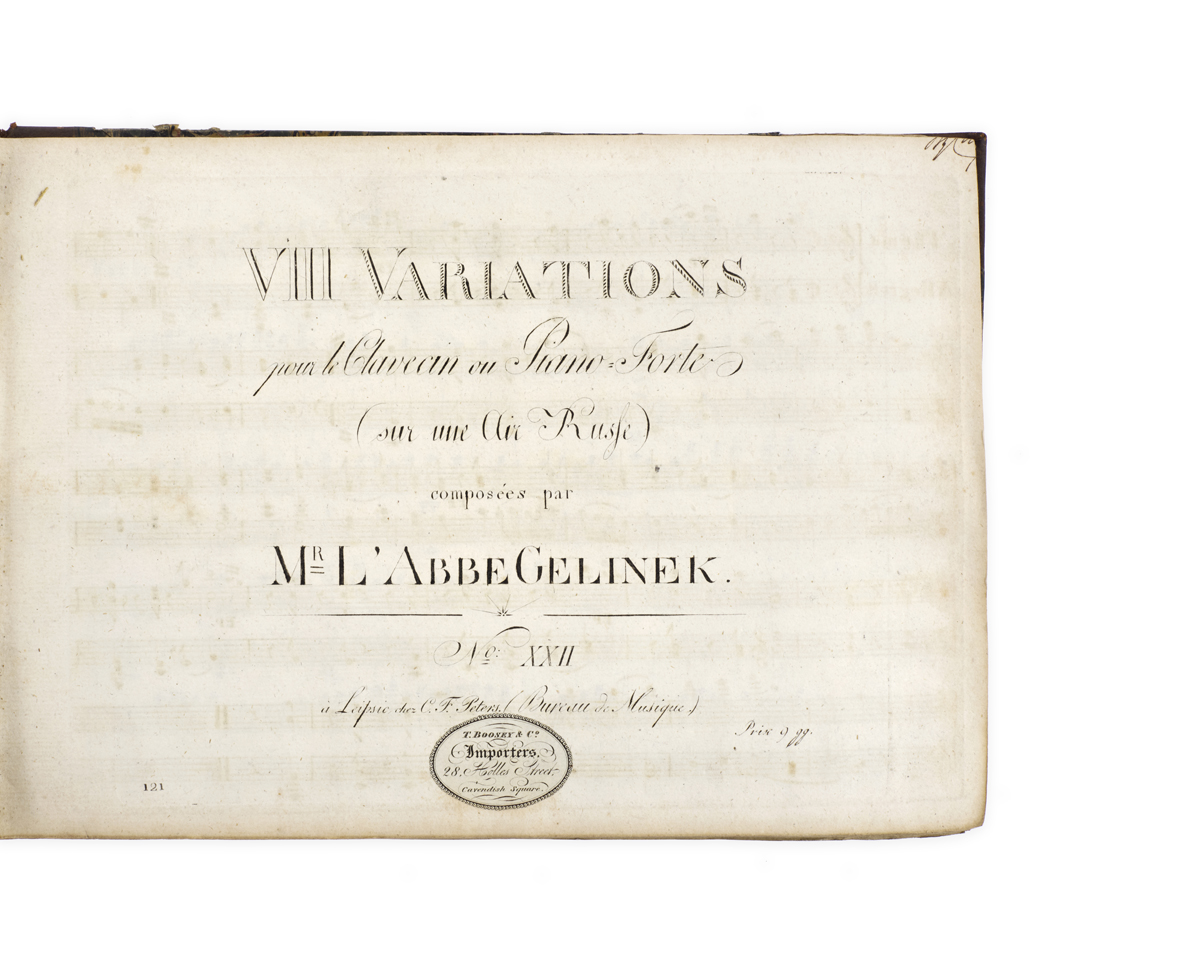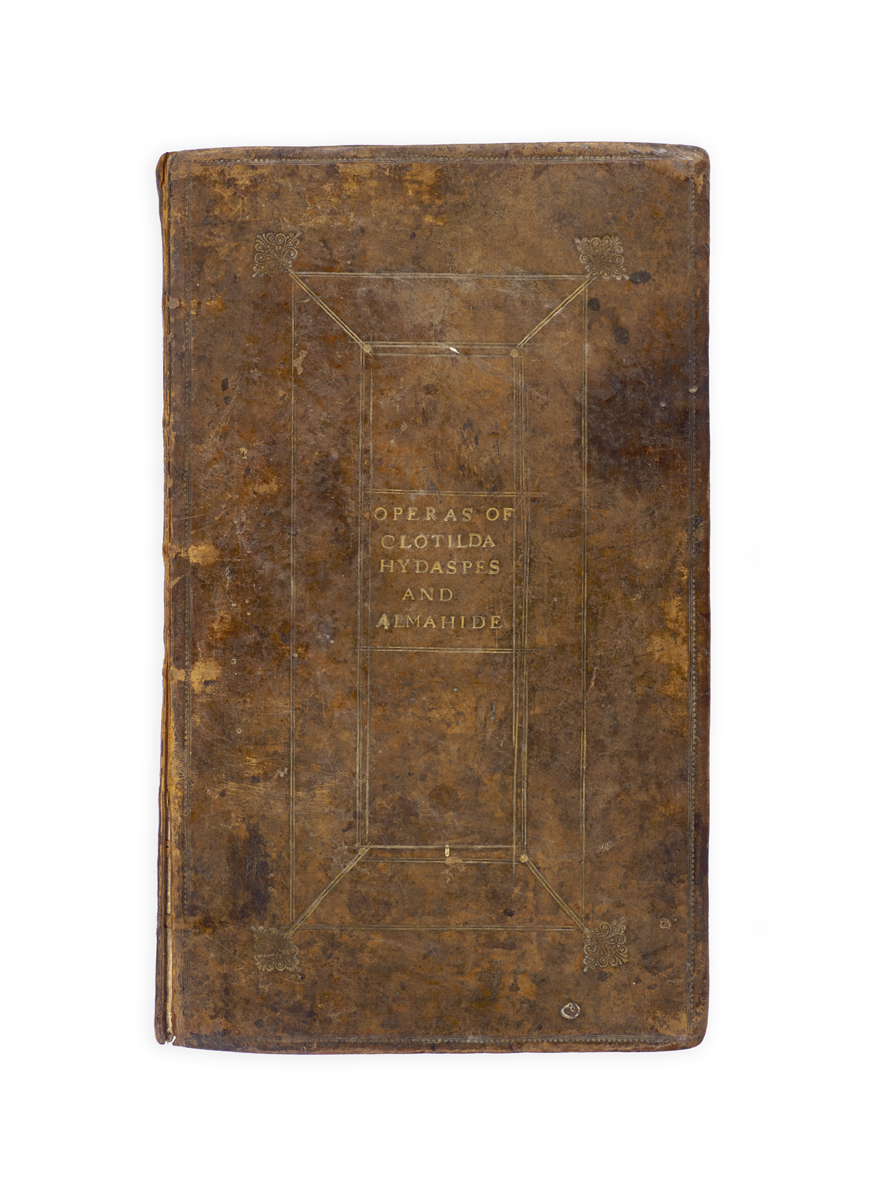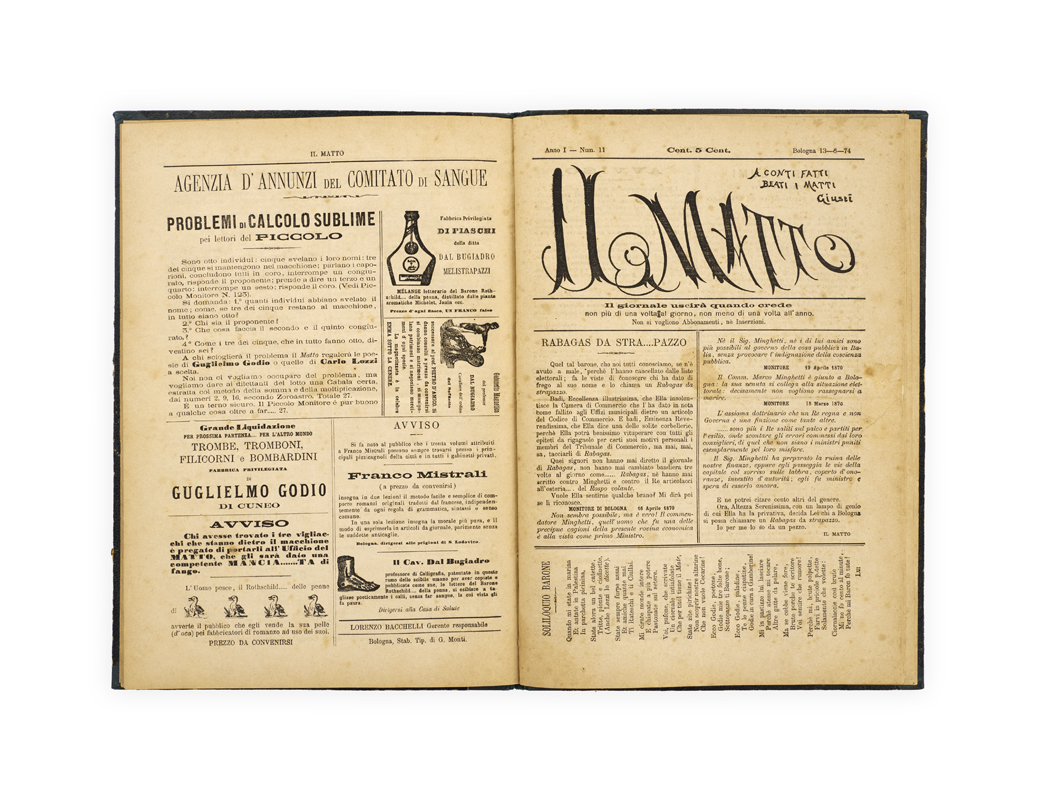

[GRAND TOUR.]
Sammelband of nine manuscript and four printed works for solo piano and for voice with piano accompaniment.
[Italy and Germany, c. 1815.]
Oblong quarto (c. 225 x 310 mm), contents as listed below; title of first work in volume slightly dust-soiled, final leaf lightly stained, some occasional dust-soiling elsewhere, a few corners curled, but generally in excellent condition; bound in English diced half Russia with marbled sides, spine gilt in compartments, gilt russia label on upper board lettered ‘MANUSCRIPT’; slightly rubbed, upper joint split, spine chipped at foot and becoming loose.

Added to your basket:
Sammelband of nine manuscript and four printed works for solo piano and for voice with piano accompaniment.
An attractive compilation of solo piano music and popular songs, gathered partly in Italy circa 1815–16 (no doubt during a Grand Tour) and bound up in England shortly afterwards.
Many of the items here are scribal copies of popular pieces by composers active in Italy in the second decade of the nineteenth century; one item bears the inscription ‘Firenze’ and was doubtless acquired in Florence. The final manuscript item in the volume was inscribed with the date 12 August 1816 at Interlaken in Switzerland, a popular staging post on the Grand Tour (Lord Byron was there just over a month later), while one of the printed items was acquired from the London bookseller Thomas Boosey.
Contents:
CARAFA (DE COLOBRANO), Michele. ‘Ariette con accompagnamento di pianoforte del sig. Michele Carafa’. Manuscript in brown ink in an Italian hand, ff. [4]. RISM 850781108 records one other copy only (Parma, Biblioteca Palatina MS Borb.157.a).
ISOUARD, Nicolas. Overture de l’opera Joconde pour le pianoforte. Hamburg, A. Cranz, [c. 1815]. Pp. 9. One of several early editions; this edition not found in RISM.
GELINEK, Josef. VIII Variations pour le clavecin ou piano-forte (sur une air Russe) composées par Mr L’Abbe Gelinek. No. XXII. Leipzig, C. F. Peters, [date?]. Pp. 11. Bears the contemporary oval printed label ‘T. Boosey & Co. Importers, 28, Holles Street, Cavendish Square’ at the foot of the title. Not found in RISM; RISM A/I G 980 records a (probably earlier) Vienna edition. ‘Most of Gelinek’s works are piano variations based on melodies from stage works (by Gluck, Paisiello, Mozart, Salieri, Méhul, Cherubini, Weigl, Müller, Winter, P. Wranitzky, Gyrowetz, Boieldieu, Rossini, Weber etc.), instrumental compositions (Beethoven’s Seventh Symphony, second movement), Viennese folktunes and his own themes. Their execution demands an advanced performer’ (Grove Online).
GELINEK, Josef. Pot-pourri für’s forte-piano nach Sargino, Camilla und Achilles von Gelinek. No. 3. Hamburg, Cranz [c. 1815]. Pp. 13. RISM A/I G 1430. ‘Many of the numerous variations, fantasias and potpourris attributed to [Gelinek] are spurious’ (Grove Music Online).
GELINEK, Josef. Zweites pot-pourri für’s forte-piano nach arien aus Tancred, Johann von Paris und der Schweizerfamilie. Hamburg, Rudolphus, and Altona, Cranz, [c. 1815]. Pp. 11. RISM A/I G 1426.
‘No. 4. No. 12. Canzonette Veneziane Raccolta No. 4’. Manuscript in dark brown ink in an Italian hand, ff. [13].
‘No. 5. No. 12. Canzonette Veneziane Raccolta No. 5’. Manuscript in dark brown ink in the same hand as previous item, ff. [13].
GALLENBERG, (Wenzel) Robert, Graf von. ‘Grande Polonaise du Ballet de Cendrillon composée par W Rob[ert]o Comte de Gallenberg et arrangée pour le pianoforte par l’auteur’. Manuscript in dark brown ink, ff. [21]. Not found in RISM. Gallenberg’s piano reductions were widely copied and distributed. Cendrillon was in fact an opera by Isouard, first performed in 1810.
ROSSINI, Gioachino. ‘Scena e cavatina Tu che accendi questo core del Sigo. Gioacchino Rossini nel Tancredi con accompag[namen]to di piano forte’. Manuscript in an Italian hand in dark brown ink, ff. [7], initials ‘R P C’ and ‘Firenze’ inscribed in upper right-hand corner of title in a contemporary English hand. The cavatina ‘Tu che accendi questo core’ is here preceded by ‘Oh patria! Dolce e ingrate patria’, also from Tancredi.
ROSSINI, Gioachino. ‘Tu che accendi questo core. Cavatina con l’accompagnamento di piano forte del Sig[no]re Giovachino Rossini’. Manuscript in an Italian hand in dark brown ink, ff. [6]. Another copy of ‘Tu che accendi questo core’.
FAVIER, Alessandro. ‘No. 18. Quadriglie per piano-forte composte espressamente dal Sig[no]re Alessandro Favier’. Manuscript in an Italian hand in dark brown ink, ff. [12], initials ‘R P C’ in a contemporary English hand in upper right-hand corner.
ROSSINI, Gioachino. ‘Mille sospiri, e lagrime [from Aureliano in Palmira]. Duetto con l’accompagnamento di pian-forte del Sig[no]re Giovacchino Rossini’. Manuscript in an Italian hand in dark brown ink, ff. [8].
FAVIER, Alessandro. ‘Quadriglie valzer e contradanze Inglesi ridotte p[er] piano-forte. Musica del Sig[no]re Alessandro Favier’. Manuscript in an Italian hand in dark brown ink, ff. [28], additional piece (‘Swiss Air’) added in a different hand on verso of final leaf, inscription in an English hand (partly trimmed) at head of verso of final leaf: ‘Interlaken … August 12th 1816’.
Provenance: from the collection of the earls Howe, and by descent. The initials ‘R P C’, which appear on two of the items here, may well be those of Richard William Penn Curzon (afterwards Curzon-Howe), first Earl Howe (1796–1870). Curzon-Howe was Lord Chamberlain to Queen Adelaide from 1830 to 1831 and again from 1834 to 1837.

